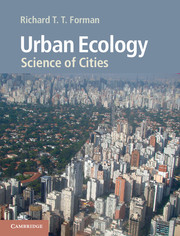Book contents
- Frontmatter
- Dedication
- Contents
- Foreword
- Preface
- Acknowledgments
- Part I Framework
- Part II Ecological features
- 4 Urban soil and chemicals
- 5 Urban air
- 6 Urban water systems
- 7 Urban water bodies
- 8 Urban habitat, vegetation, plants
- 9 Urban wildlife
- Part III Urban features
- Epilogue
- Appendix A Positive and negative attributes of an urban region
- Appendix B Equations
- References
- Index
9 - Urban wildlife
Published online by Cambridge University Press: 05 June 2014
- Frontmatter
- Dedication
- Contents
- Foreword
- Preface
- Acknowledgments
- Part I Framework
- Part II Ecological features
- 4 Urban soil and chemicals
- 5 Urban air
- 6 Urban water systems
- 7 Urban water bodies
- 8 Urban habitat, vegetation, plants
- 9 Urban wildlife
- Part III Urban features
- Epilogue
- Appendix A Positive and negative attributes of an urban region
- Appendix B Equations
- References
- Index
Summary
Animals must move across land to survive – for water, for food, for minerals. Existence depends upon some kind of movement: you move, or the land kills you where you stand.
Brian Herbert and Kevin J. Anderson, Dune: The Butlerian Jihad, 2002And drink pure water from the pump,
I gulp down infusoria
And quarts of raw bacteria,
And hideous rotatorae,
And wriggling polygastricae,
And slimy diatomacae,
And various animalculae
Of middle, high and low degree.
William Juniper, The True Drunkard’s Delight, 1933
Some years ago I tried to call the “National Center for Urban Wildlife” in Washington, D.C. and after futile attempts to find the number, the telephone operator said politely, “Sir, are you really serious?” While cities may be hot spots of human wild life, I was thinking of urban wildlife, the non-domesticated terrestrial animals in urban areas (Goode, 1986; Houck and Cody, 2000; USDA Forest Service, 2001; Adams et al., 2006). Wildlife refers to all vertebrates (mammals, birds, reptiles, amphibians) and invertebrates (insects and other groups), except for pets, farm animals, fish, and diverse aquatic animals.
The urban environment, characterized by a concentration of buildings, roads, pollutants, noise, vehicles, and people, differs markedly from natural and agricultural lands. Not surprisingly, urban animals are equally distinctive (Stearns, 1967; Robinson, 1996). In general, urban vertebrates: (1) commonly use human-provided food sources; (2) readily switch diets; (3) may den or nest in artificial structures; (4) have relatively long breeding periods; (5) may occur in rather high density; (6) frequently move from location to location; (7) are habituated (accustomed to or behaviorally adjusted to humans); and (8) are generalists (Wheater, 1999; Adams et al., 2006).
- Type
- Chapter
- Information
- Urban EcologyScience of Cities, pp. 241 - 274Publisher: Cambridge University PressPrint publication year: 2014



